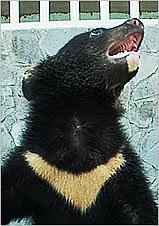
world-science.net
May 28, 2013
Courtesy of Max-Planck-Gesellschaft
and World Science staff
If you’ve ever
experienced how hard it is to sneak up on a fuzzy but unwanted
little rodent, here may be your explanation.Courtesy of Max-Planck-Gesellschaft
and World Science staff
Rats see the world very differently from us, researchers say, because they’re able to keep the world above them in permanent view—but apparently can’t merge the views from both eyes into one image.
With hawks and the like trailing rodents at every opportunity, nature seems to have just decided the first ability is important enough to sacrifice the second, said the scientists.
Describing themselves as totally surprised by the discovery, they found that the rodents move their eyes in opposite directions, not together like us, when running around. Their precise eye movement, which depends on the change in the head position, prevents a “fusion” of both visual fields, the researchers added.
With people, “both our eyes move together and always follow the same object,” while counteracting head movements, said neurobiologist Jason Kerr of the Max Planck Institute for Biological Cybernetics in Tübingen, Germany, one of the researchers.
“In rats, on the other hand, the eyes generally move in opposite directions.”
Kerr and colleagues noted that despite the different ways of looking, the images from the rats’ eyes are fed into pretty much the same brain pathways as humans.
Like many mammals, rats have their eyes on the sides of their heads. This gives them a very wide visual field, good for detecting predators. But three-dimensional vision requires overlap of the two visual fields. So the rats’ visual system must meet two conflicting demands: maximum surveillance, and detailed binocular vision.
The scientists fitted tiny cameras to the animals’ heads, which could record the lightning-fast eye movements. They also used another new method to measure the head’s position and direction of the head, so they could reconstruct the rats’ exact line of view moment by moment.
“When the head points downward, the eyes move back, away from the tip of the nose,” Kerr said. “When the rat lifts its head, the eyes look forward: cross-eyed, so to speak. If the animal puts its head on one side, the eye on the lower side moves up and the other eye moves down.”
This system ensures that the area above the animal is always in both eyes’ view simultaneously, they added.
In people, the eyes’ gaze direction must be precisely aligned; even a one-degree deviation can cause double vision. In rats, the opposing eye movements mean that the line of vision varies by as much as 40 degrees in the horizontal plane and up to 60 degrees in the vertical plane, Kerr and colleagues said.
The findings were published online May 26 in the journal Nature.
..................................
台灣醒報作者: 莊瑞萌 | 台灣醒報 – 2013年5月29日 下午2:52
快速跑動的老鼠,兩眼可以同時看不同方向物體。德國科學家利用高速攝影機觀察跑動中的老鼠眼部運動,發現老鼠兩顆眼睛可同時看不同方向事物,也就是說,當老鼠在跑動時,不僅可以偵測上方動靜,還可以注意前方一舉一動。科學家認為,老鼠獨特的眼睛移動方式,就是為了觀察上方鳥類的動靜,避免遭到攻擊。
【台灣醒報記者莊瑞萌綜合報導】快速跑動的老鼠,兩眼可以同時
看不同方向物體。德國科學家利用高速攝影機觀察跑動中的老鼠眼
部運動,發現老鼠兩顆眼睛可同時看不同方向事物,也就是說,當
老鼠在跑動時,不僅可以偵測上方動靜,還可以注意前方一舉一動
。科學家認為,老鼠獨特的眼睛移動方式,就是為了觀察上方鳥類
的動靜,避免遭到攻擊。
德國「馬克斯普朗克生物模控學研究所」科學家將小型高速攝影機
裝在老鼠頭
上,觀察老鼠眼睛移動,另一部攝影機則觀察老鼠頭部移動,藉此
觀察老鼠是如何觀察身旁一切動靜。事後科學家重建老鼠之前所看
的景象發現,老鼠跟人類看東西方式截然不同,因為牠們是將2個獨
立畫面,一起傳給大腦處理,而且不會混淆。
研究者寇爾表示,「人類利用眼睛觀看前方事物,兩眼通常同一時
間定焦在同一物體上,但老鼠的兩顆眼睛,卻可以同時觀看相反方
向的移動物體,」而且人類2顆眼睛的對角角度,必須超過1度以上
,才能看清物體,否則會產生雙重影像,但是老鼠視線則不受限,
其兩眼距離水平面可以超過40度,垂直面可超過60度以上。
老鼠除了看事物的方式與人類不同,其嗅覺更是有特殊作用,因為
根據美國凱斯西儲大學研究發現,老鼠們彼此溝通是靠嗅覺來決定
地位,一般而言,地位較高的老鼠,可以多聞對方,但若是較年輕
的老鼠多聞幾下,就會導致被其他老鼠攻擊的命運。
本次研究結果已刊登在《自然》期刊。
圖說:德國研究發現,老鼠觀看事物的方式與人類不同,其2眼可以
觀察不同方向的事物,其原因可能是避免被天空的掠食者攻擊,而
逐漸演化成這項功能。
